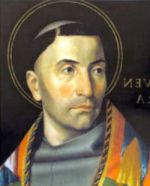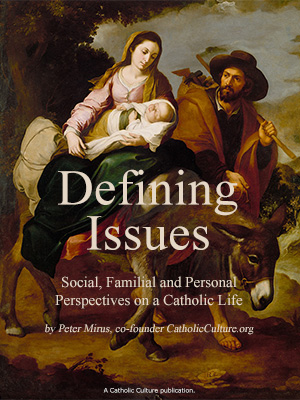The structure of Catholic revolutions?
By Phil Lawler ( bio - articles - email ) | Mar 11, 2025 | In Reviews
The Structure of Scientific Revolutions, by Thomas Kuhn, had an enormous influence on academic discourse in the 1960s and 1970s, introducing the concept of the “paradigm shift” into common usage. Kuhn argued persuasively that scientific progress occurs not steadily, but in leaps and bounds, as new discoveries and/or new theories force researchers to abandon old assumptions and look at the world in entirely new ways. The new paradigm is accepted if it explains that world more successfully—in other words, if it produces better results. Hold that thought.
In 1980, the historian George Marsden used the concept of the “paradigm shift” to explain a 20th-century development among Protestants, in his book Fundamentalism and American Culture. He suggested that the “fundamentalists” were unable to accept a new paradigm of theological studies, and consequently remained stuck in their own paradigm, unable to adjust to a Protestant world that had passed them by.
Now Oxford University Press, which published the Marsden book, follows up with Catholic Fundamentalism in America, by Father Mark Massa, the director of the Boisi Center for Religion and American Public Life at Boston College. Massa readily acknowledges his reliance on Marsden’s analysis, as he applies the same analysis to the Catholic world. When you know that Father Massa is also the author of The American Catholic Revolution: How the Sixties Changed the Church Forever, you can easily imagine the “paradigm shift” he has in mind.
In applying the term “fundamentalist” to some Catholics, Massa faces a challenge, because very few Catholics would accept that description. The staunch Protestants portrayed by Marsden, on the other hand, proudly rallied around the “five fundamentals,” the first of which was their unflagging belief in the inerrancy of Scripture. (The other four “fundamentals” are the virgin birth, the substitutionary atonement, the physical Resurrection, and the Second Coming.)
Retracing Marsden’s path through American cultural history, Massa underlines the radical shift that took place in Protestant theology early in the 20th century:
The fundamentalists’ literal reading of the Bible (“biblical inerrancy”) was not something fundamentalist believers invented out of whole cloth in 1919; just a few years earlier, the vast mainstream of American Protestants would have accepted it without a second thought.
But rather suddenly, during the 20th century, mainstream Protestants lost their confidence in the inerrancy of Scripture, under the influence of scholars whose historical-critical approach allowed for new interpretations of the Bible. Soon the other four “fundamentals” were also eroding, as were the traditional moral principles that all Christians once held in common. This was the new paradigm that the fundamentalists resisted.
Now pause for a moment and reflect. Has this new paradigm produced better results? Are mainstream Protestant communities stronger for their acceptance of this new approach?
Exactly. In the world of science, radical new theories face entrenched resistance, but eventually that resistance succumbs to the force of experimental results. Only eccentrics cling to a belief in the flat earth or the phlogiston theory. In the world of religion debates are not so easily resolved. Massa clearly sees the “paradigm shift” that erupted in American Catholicism after Vatican II (although it was rumbling underground—and in Europe—earlier) as a great leap forward. But where are the results?
Actually Massa begins his study before Vatican II, with the case of Father Leonard Feeney, who drew the ire of Church leaders with his militant insistence that there is “no salvation outside the Church.” That phrase, which became the rallying cry of the Feeneyite movement, “was hardly controversial,” Massa concedes. “But the all-important question of what that phrase meant was something else entirely.” Father Feeney and his followers held to a strict interpretation of the traditional teaching, denounced as liberals those who disagreed, and, when bishops failed to support them, took a confrontational attitude toward the hierarchy.
Massa sees that confrontational attitude—the unwillingness to accept the new paradigm and play by the new rules—as one key characteristic shared by the otherwise disparate movements he examines in Catholic Fundamentalism. Using this framework he fits Father Gommar DePauw, Mother Angelica and EWTN, the Society of St. Pius X (SSPX), Christendom College, Church Militant, and Crisis magazine under the general category of “fundamentalist.”
Anyone who is personally familiar with the people involved in Massa’s case studies will immediately remark on the differences among them: differences that have sometimes produced heated conflicts. But Massa paints with bold strokes, confident in his own judgments. Terms such as “obviously” and “of course” crop up with annoying frequency in his work. At times it becomes evident that he sees his subjects from a great distance, as for instance when he describes the founders of Crisis magazine, Ralph McInerny and Michael Novak, as both “certainly card-carrying neo-conservatives”—which Novak certainly was, and McInerny just as certainly wasn’t.
Intent on driving home his before-and-after view of Catholic beliefs, Massa sees irony in the fact that the SSPX, which excoriates Pope Paul VI for abandoning the traditional Latin liturgy, nevertheless supports Humanae Vitae, an encyclical written by the same Pontiff. He misses the point that the key teaching of Humanae Vitae was not a novelty introduced by Paul VI, but a constant element of the tradition that the SSPX claims to uphold.
Massa can be tone-deaf at time, as when he alludes to “that particular Church Militant hobbyhorse—that American Catholic bishops have conspired to cover up sex abuse by clergy…” Surely that complaint was not exclusive to Church Militant—nor for that matter to “fundamentalist” Catholics. Did some of the latter push the criticism further than Massa thought appropriate? No doubt. But since the author of Catholic Fundamentalism laments the willingness of his study’s subjects to present the arguments of their adversaries in the worst possible terms, perhaps he should not have characterized the editorial outlook of Crisis today as “a radically sectarian, a-historical, primitivist, and pre-millennial understanding of the tradition of Catholic Christianity.”
To be fair, in most of his analysis Massa is more even-handed of his subjects. But his failure to understand the people he portrays is evident especially in his concluding chapter, when he attempts to summarize his findings and explain the similarities he sees among these “fundamentalist” Catholics. When he says, for instance, that the vision of Mother Angelica was “far from wanting to engage in debate to convert mainstream American or Catholic culture,” he is not describing the woman I knew. Yes, all of the movements that he describes have sought to restore an older understanding of the Catholic faith: an old paradigm, if you will. Massa suggests that this necessarily means closing oneself off from contemporary society. Couldn’t it just as easily mean inviting the mainstream to explore the beauties of an ancient heritage?
As he rounds toward his conclusion Massa remarks on one key difference between Protestant and Catholic “fundamentalists,” saying that “the core question in Catholic fundamentalism was not ‘who are the elect?’ but ‘who are the real Catholics?’” Quite so. But if the Catholic Church proclaims that the truths of the faith are eternal and unchanging, surely there is reason to suspect any “new paradigm.” And if we must apply Kuhn’s thesis to the Catholic faith, we should notice which “paradigm” brings more people into active participation in the sacramental life of the Church. “You will know them by their fruits.”
All comments are moderated. To lighten our editing burden, only current donors are allowed to Sound Off. If you are a current donor, log in to see the comment form; otherwise please support our work, and Sound Off!
-
Posted by: ewaughok -
Mar. 12, 2025 11:43 AM ET USA
Thanks, Mr. Lawler for the blast from the past! It was in 1961, if I remember correctly that Kuhn published his groundbreaking book. Much changed since then in the study of the history of science, as Kuhn acknowledged later in life. In particular, the notion of “revolutions” has been recast several times, most notably by Paul Feyerabend, whom Pope Benedict XVI quoted approvingly more than once. To think that Fr Massa would dig up 63 year-old dated scholarship to frame his work, boggles the mind!








